 |
| 熊野・南紀旅行 11月12 - 14日 Kumano and Nanki Trip 12 -14th of November Kii Peninsula Trip |
目次 / Contents
1) 場所 / Place
2) ここは、お寺? / Is Here a Temple?
A. 店と本堂 / Shop and Hall
B. 地底36mへ / To 36m Underground
3) 洞窟内 / In the Cave
A. 海蝕洞 / Sea Cave
B. 十像岩 / Ten Statue Rocks
C. 弁財天 / Benzaiten
D. 鉱山 / Mine
E. 熊野水軍 / Kumano Navy
F. 侵食 / Erosion
1) 場所 / Place
伝承が残る史跡でもあります。
(熊野水軍の詳細についてはここで→★)
秘密基地の匂いがプンプンする魅惑的な場所です。
[ 2002 - 2017 / ゴア・ヴァービンスキー(1964 ~ )]
を彷彿させる設定です。
熊野水軍が最もその名を知られることになったのは、
での、その役割です。
私は、当初、村上水軍と誤解し、また
に登場する、小松三郎尚隆 (コマツサブロウナオタカ / 後の雁王) を思い出しました。
三段壁も景勝地として有名で、高さ50mの約2kmの急な崖で構成されています。
三段壁洞窟見学後、私達は、三段壁にも行きました。
 |
| 赤い部分 : 和歌山県 Red Part : Wakayama Prefecture 画像は下記より / This from below ★ |
 |
| 和歌山県 黄土色部分:白浜町 Wakayama Prefecture Yellow Ochre Part : Shirahama chō (Shirahama Town) 画像は下記より/ This from below★ |
 |
| ★ : Sandanbeki Rock Cliff Cave 画像は下記より / This from below ★ |
Place
Next to Adventure World, we went to Sandanbeki Rock Cliff Cave : ★ (only in Japanese).
The Sandanbeki Rock Cliff Cave is a cave hidden 36m underground in the Sandanbeki Rock Cliff in Shirahama Town, Nishimuro District, Wakayama Prefecture.
It is also a historic site where the Kumano Navy (Kumano Pirates) in the Heian period (794 - 1185) once hid their ships.
It's a fascinating place where I smell the secret base.
The setting is reminiscent of "Pirates of the Caribbean" [ 2002 - 2017 / Gregor Justin Verbinsk (1964 ~ )]
The Kumano Navy became most famous for its role in Genpei War (1180 - 1185).
At first, I misunderstood it as the Murakami Navy, and also remembered Naotaka Komatsu (later, King En), who appeared in "The Twelve Kingdoms" [Jūninikokki / by Fuyumi Ono (1960 ~) / 1992 ~ present].
Sandanbeki Rock Cliff is also famous as a scenic spot, and is composed of steep cliffs with a height of 50m and about 2km long.
After visiting the Sandanbeki Cave, we also went to Sandanbeki Rock Cliff.
2) ここは、お寺? / Is here a temple?
A. 店と本堂 / Shop and Hall
地底36mの洞窟へ行くには、お店でチケットを買い、このお店の中のエレベーターに乗って降りてゆきます。
辯天宗は、大森 智辯 (オオモリ チベン / 1900 - 1967 / 本名・大森清子) によって1952年に開かれた高野山真言宗派です。
経営しています。
智辯学園高等学校は、甲子園の常連校で、野球にあまり詳しくない私でも、その名を知っています。
辯天宗は、1934年に開かれた新興宗教であるものの、かなり日本に定着している印象があります。
宗教というよりは、ある理念に基づく学校経営が成功しているというビジネス (会社?) に私には感じられます。
Shop and Hall
To get to the 36m underground cave, buy a ticket in the shop and take the lift inside this shop to get down.
Actually, this shop is the main hall of Benten-shū (★: only in Japanese).
Benten-shū is a Japanese Buddhist sect, was opened by Chiben Omori (1900 - 1967/ Real name, Kiyoko Omori) in 1952 and following of Kōyasan Shingon-shū sect.
Benten-shū runs Chiben Gakuen Schools in Nara and Wakayama prefectures.
Chiben Gakuen High School competes regularly in 'Koshien', which means National High School Baseball Championship, and even I, who is not very familiar with baseball, know the name.
Although it is a new religion that was begun in 1934, I have the impression that it is well established in Japan.
I feel that the schools with a certain philosophy are successful in the business of school management rather than because they focus on their religion.
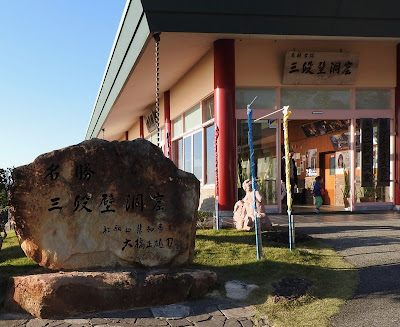 |
| 辯天宗 本堂 この建物(お店)は、全くお寺らしく見えません。 辯天宗は、神仏習合 (シンブツシュウゴウ)を 絵に描いたような宗教のように感じます。 弁財天は洞窟内に祀られています。 大森 智辯は、弁財天により天啓を受け、 辯天宗を創設したと言われています。 Benten-shū Hall This building (shop) doesn't look like a temple at all. Benten-shū feels like a picture-like religion of Shinbutsu-shūgō. Benzaiten is enshrined in the cave. It is said that Chiben Omori received divine revelation from Benzaiten and founded Benten-shū.  庭が多少お寺らしいでしょうか? この下に秘密めいた場所があることが想像できません。 だからこそ、秘密基地なのでしょうか? Is the garden a little like a temple? I can't imagine a secret place underneath. That's why it's a secret base?  住所: 〒649-2211 和歌山県西牟婁郡白浜町2927-52 Address : 2927-52 Shirahama-cho, Nishimuro-gun, Wakayama Prefecture, 〒649-2211 |
店内に / In the Shop
 |
熊野水軍の船の模型 紋が、'左三つ巴'。 '左三つ巴'は、水が渦を起こす様子を デザイン化したものです。 熊野水軍が使用していたかは私にはわかりません。 清和源氏系に使用されたので、製作者が この紋を選択したのかもしれません。 が使用しました。 Kumano Navy Ship Model The crest is 'Left -Tomoe '. The design of "Left -Tomoe" came from how water swirls. I don't know if it was used by the Kumano Navy. Since it was used by some of Seiwa Genji group, the creator may have chosen this crest. By the way, this crest was used by Shinsengumi Deputy Chief, Hijikata Toshizō (1835 - 1869). 帆船はロマティック! 模型が好きです。 ガラス窓の向こうは、本物の海です。 Sailing Ship is Romantic! I like models. The sailing ship is romantic! Beyond the glass window is the real sea. |
B. 地底36mへ / To 36m Underground
私はツアー参加者なので、直接は入場料を支払いませんでしたが、一般の大人・個人は、1,300円 (2019年) の入場料が必要です。
This cave is a Sea Cave and was formed on a sea cliff by wave erosion.
瀬戸鉛山鉱山とも呼ばれる。
金・銅・鉛・亜鉛が採掘された。
天文12年8月の鉄砲伝来以降、銃弾に用いる鉛の需要が増大するようになったという。
1954(昭和29)年時点で昭和鉱業(株)が経営していたが、鉛の産出量は微量で主に亜鉛が採掘されていたらしい。
現在の白浜ゴルフ倶楽部、旧白浜空港の西側の地域に約三百の鉱穴(まぶあな)があったという。"
でもそれは、ここに限ったことではなく、日本各地の海賊はそのようでした。
Interestingly enough, depending on the time period and the situation, the pirates sometimes fought battles as members of a feudal lord's navy.
But that wasn't the only place, pirates all over Japan did.
一般的な寺の拝観料は、0 ~ 700円くらいのように思います。
それに比べると、ここは、洞窟の弁財天の拝観料としては高いですが、この貴重な場所を維持するためには仕方がないように思います。
ちなみに法隆寺は1,500円、まあ、格が違うというと、ここに失礼でしょうか?
[法隆寺は、607年創建、推古天皇 (554 - 628 / 在位:593 - 628) と
聖徳太子 (574 - 622) によって開かれ、"法隆寺地域の仏教建造物"として、日本初の世界遺産に登録され、所蔵の国宝、重要文化財は数えきれません。]
一応、法隆寺より高い拝観料は取れないということで、配慮されたのではないですか?
私にとっては、'熊野水軍の秘密基地'を想像させてくれる代金と思えば、納得です。
タイムトンネル的役割のエレベーター代ですね。
ですが、ただの観光と思う人は高いと感じるのかもしれません。
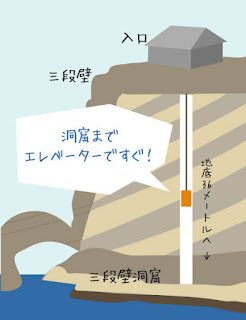 |
| エレベーターで エレベーターで地中を降りると、 洞窟内部に到着します。 案内の方が軽く説明してくれます。 By Lift Take the lift down to reach the inside of the cave. The guide briefly explained to us about the cave. 画像は下記より / This from below ★ |
To 36m Underground
Since I was a tour participant, I did not pay the admission fee directly, but general adults and individuals need an admission fee of 1,300 yen (2019).
I think that the admission fee for a general temple is about 0 to 600 yen in Japan.
Compared to that, this is a high admission fee for Benzaiten in the cave, but I think there is no choice but to maintain this precious place.
By the way, Hōryū-ji Temple is 1,500 yen, and if I say its rank is different from here, is it rude to here?
[Hōryū-ji Temple was founded in 607 and was opened by
Empress Suiko (554 - 628 / Reign: 593 - 628) and
Prince Shōtoku (574 - 622), and this temple along with Hokki-ji, was registered as the first World Heritage Site in "Buddhist Monuments in the Hōryū-ji Area", and they hold innumerable National Treasures and Important Cultural Properties.]
For the time being, here cannot take the admission fee higher than that of Hōryū-ji Temple, so they considered, didn't they?
For me, it makes sense to think of it as the price that makes me imagine the 'Kumano Navy's secret base'.
It's a lift fee that plays a role like a time tunnel.
However, people who think that it is just sightseeing may find it expensive.
4) 洞窟内 / In the Cave
A. 海蝕洞 / Sea Cave
This cave is a Sea Cave and was formed on a sea cliff by wave erosion.
B.十像岩 / Ten Statue Rock
 |
| 洞窟から外を見る 洞窟の端から海と三段崖を見ます。 この方向の逆に十像岩があります。 Outside From Cave View the sea and Sandanbeki Rock Cliff from the edge of the cave. In the opposite direction, there is "Juzo Rocks" : "Ten Statue Rocks". |
 |
| 見上げると、こんな感じ Looking up, it looks like this |
 |
洞窟内 / Inside of Cave 洞窟の奥を見る ここに海賊船の基地があったと言われています。 Look at the back of the cave It is said that there was a pirate ship base here. |
C. 弁財天 / Benzaiten
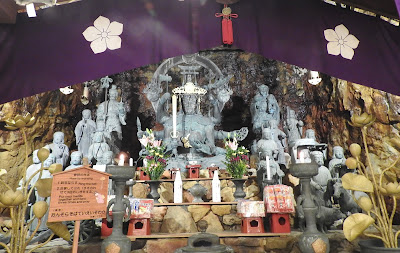 井牟婁大辯才天と16童子 (ムロダイベンザイテン) |
| 日本の弁財天は独自の変容をとげ、インドや中国で伝えられるそれらとは違います。 "七福神"の一神で、水と芸能の神で、化身は蛇や龍という認識が私にはあります。 江ノ島の神も弁財天ですし、多数の場所で弁財天は 祀られています。 童子は弁財天の眷属神 (ケンゾクシン) とされています。 弁財天は神仏習合の代表的な存在に思えます。 辯天宗は新興宗教なので、 この宗教なりの独自の捉え方があります。  Murodai-Benzaiten and 16 Doji Benzaiten in Japan has undergone its own transformation and is different from those reported in India and China. I have the recognition that it is one of the "Seven Lucky Gods", the God of water and performing arts, and the incarnation is a snake or a dragon. The god of Enoshima Island is also Benzaiten, and Benzaiten is enshrined in many places. Doji is the name given to Kenzoku, such as Buddha, Bodhisattva, and Wisdom King. These Doji, above are Benzaiten's Kenzokushin (ancillary deities). In my view, Benzaiten seems to be a representative of Shinbutsu-shūgō. Since Benten-shū is a new religion, it has its own way of thinking. |
According to Wiki about Enoshima Island,
"Enoshima (江の島) is a small offshore island, about 4 km (2.5 mi) in circumference, at the mouth of the Katase River which flows into the Sagami Bay of Kanagawa Prefecture, Japan. Administratively, Enoshima is part of the mainland city of Fujisawa, and is linked to the Katase section of that city by
a 600-metre-long (2,000 ft) bridge. Home to some of the closest sandy beaches to Tokyo and Yokohama, the island and adjacent coastline are the hub of a local resort area.
Benzaiten, the goddess of music and entertainment, is enshrined on the island. The island in its entirety is dedicated to the goddess, who is said to have caused it to rise from the bottom of the sea in the sixth century.[1] The island is the scene of the Enoshima Engi, a history of shrines on Enoshima written by the Japanese Buddhist monk Kōkei in 1047 AD."
D. 鉱山 / Mine
洞窟の通路の写真が焦点がなく、ボケています、すみません。
The photographs in the cave passage is out of focus and blurry, sorry.
 |
| 洞窟の通路 Cave Passage |
 |
| 洞窟内案内図 Cave Guide Map in Japanese 画像は下記より / This from below ★ |
 |
| 鉱山の説明板 写真がボケボケちゃんですみません。 Information Board about Mine I'm sorry that the photo is blurry. |
下記、要約
"瀬戸鉛山鉱山(セトカナヤマコウザン)は、現白浜町三段地域に、
"瀬戸鉛山鉱山(セトカナヤマコウザン)は、現白浜町三段地域に、
正親町天皇 (オオギマチテンノウ/ 1517 - 1593 / 在位:1557 -1586)
の時代に開鉱されたと伝えられています。
の時代に開鉱されたと伝えられています。
特に1543年、鉄砲伝来以降銃弾に用いる鉛の需要が増大しました。
が、1733年にこの鉱山は中止になりました。
その免税書が今も残ってます。"
基本、江戸時代 (1603 - 1868) 初期に使用された鉱山がここにあったのですね。
熊野水軍が使用した通路と鉱山の通路の違いが私にはわかりませんでした。
下記、'廃墟検索地図'サイトより。
"鉛山鉱山(かなやまこうざん)は和歌山県西牟婁郡白浜町にあった鉱山。瀬戸鉛山鉱山とも呼ばれる。
金・銅・鉛・亜鉛が採掘された。
天文12年8月の鉄砲伝来以降、銃弾に用いる鉛の需要が増大するようになったという。
1954(昭和29)年時点で昭和鉱業(株)が経営していたが、鉛の産出量は微量で主に亜鉛が採掘されていたらしい。
現在の白浜ゴルフ倶楽部、旧白浜空港の西側の地域に約三百の鉱穴(まぶあな)があったという。"
鉱穴は、採掘のための縦穴のことです。
Summary from 'Information Board about Mine',
"Setokanayama Mine : Seto Lead Mine is said to have been opened in the current Shirahama Town Sandan area during the time of
Emperor Ōgimachi (1517- 1593 / reign : 1557 - 1586).
Especially, the demand for lead used for bullets increased after the introduction of guns in 1543.
However, in 1733 the mine was closed.
From the end of the 16th century to the first half of the 17th century, Asano Clan and Tokugawa Nanki Clan ( Kishū Tokugawa family?) exempted taxes and encouraged mining.
The tax exemption certificate still remains."
Basically, there was a mine used in the early Edo period (1603 - 1868) here.
I couldn't tell the difference between the passage used by the Kumano Navy and the passage in the mine.
E. 熊野水軍 / Kumano Navy
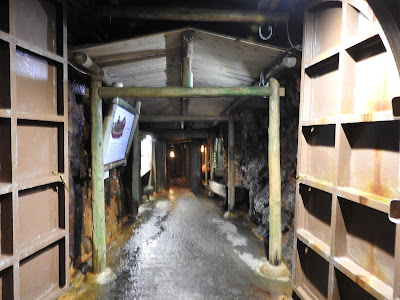 |
| 熊野水軍関係の展示通路 Kumano Navy-related Exhibition Passage |
 |
| 安宅船 (アタケブネ)の説明がされています。 安宅船は昔の戦艦。 英語の説明があって嬉しい! The explanation of the Atakebune. Atakebune is an old battleship. I am glad that there is an explanation in English!  |
興味深いことに、期間や状況によっては、海賊は封建領主の海軍の
一員として戦闘を行うことがありました。
でもそれは、ここに限ったことではなく、日本各地の海賊はそのようでした。
Interestingly enough, depending on the time period and the situation, the pirates sometimes fought battles as members of a feudal lord's navy.
But that wasn't the only place, pirates all over Japan did.
  |
 |
 |
| 水軍小屋 この中へは入ることができます。 Navy Hut We can enter here. |
F. 侵食 / Erosion
 |
| 波寄せる洞穴という感じがします。 It feels like a rippling cave.  |
 |
 |
 |
説明板 / Information Board   |
 |
  漣痕 (リップル) 下記、Wikiより 流れることにより、周期的な波状の模様が 作られた規則的な微地形のこと。 当時の流れの方向を推定することができる。 岩石の表面に刻まれた痕跡をリップルマークと呼ぶが、 未固結な状態を含み総じてリップル(ripples)ともいう。" Ripples According to Wiki about Ripples "In geology, ripple marks are sedimentary structures) and 画像は下記より / This from below |
この洞窟は、歴史、自然、伝説、宗教が入り混じっています。
多少、胡散臭さも漂うのですが、それもまた楽し!です。
また、行きたいとは思いませんが、一度行ってみるのは、面白いことだと思います。
This cave is a mixture of history, nature, legends and religions.
There is a slight shadiness, but it's also fun!
I don't want to go again, but I think it's interesting to go there once.
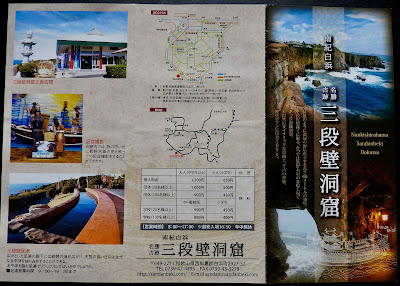 |
パンフレット / Leaflet in Japanese |
 |
| パンフレット英語版 Leaflet  |
 |
| 上 : チケット ジオラマを使用 下:記念写真の表紙 Top : Tickets Using a diorama Bottom : Cover of Souvenir Photograph  記念写真 / Souvenir Photograph |












0 件のコメント:
コメントを投稿